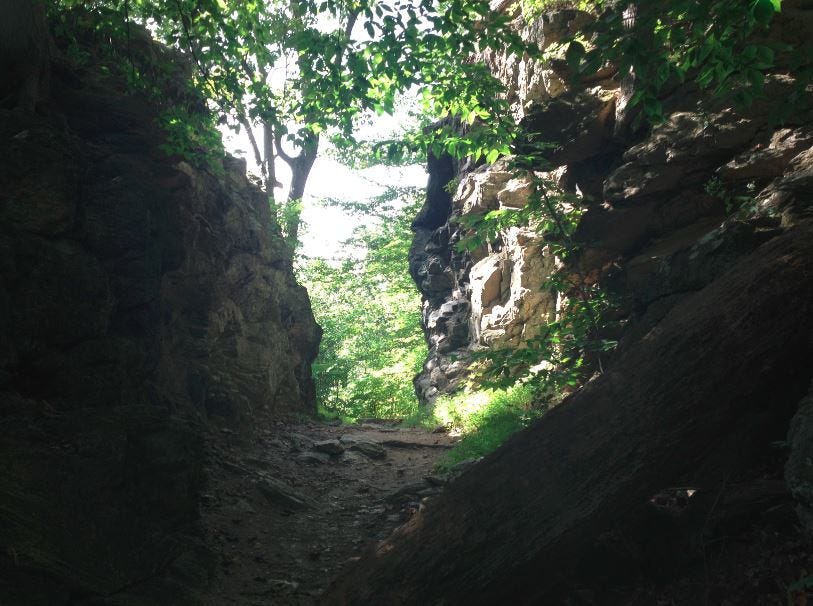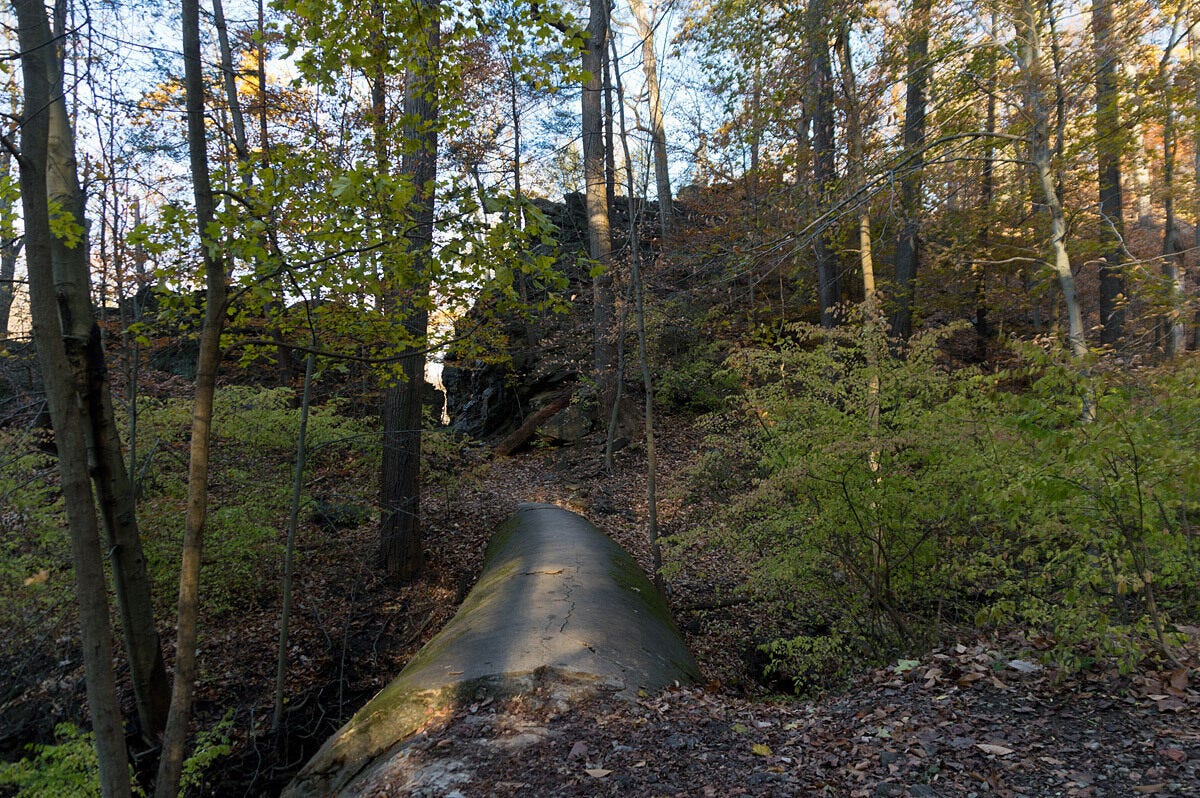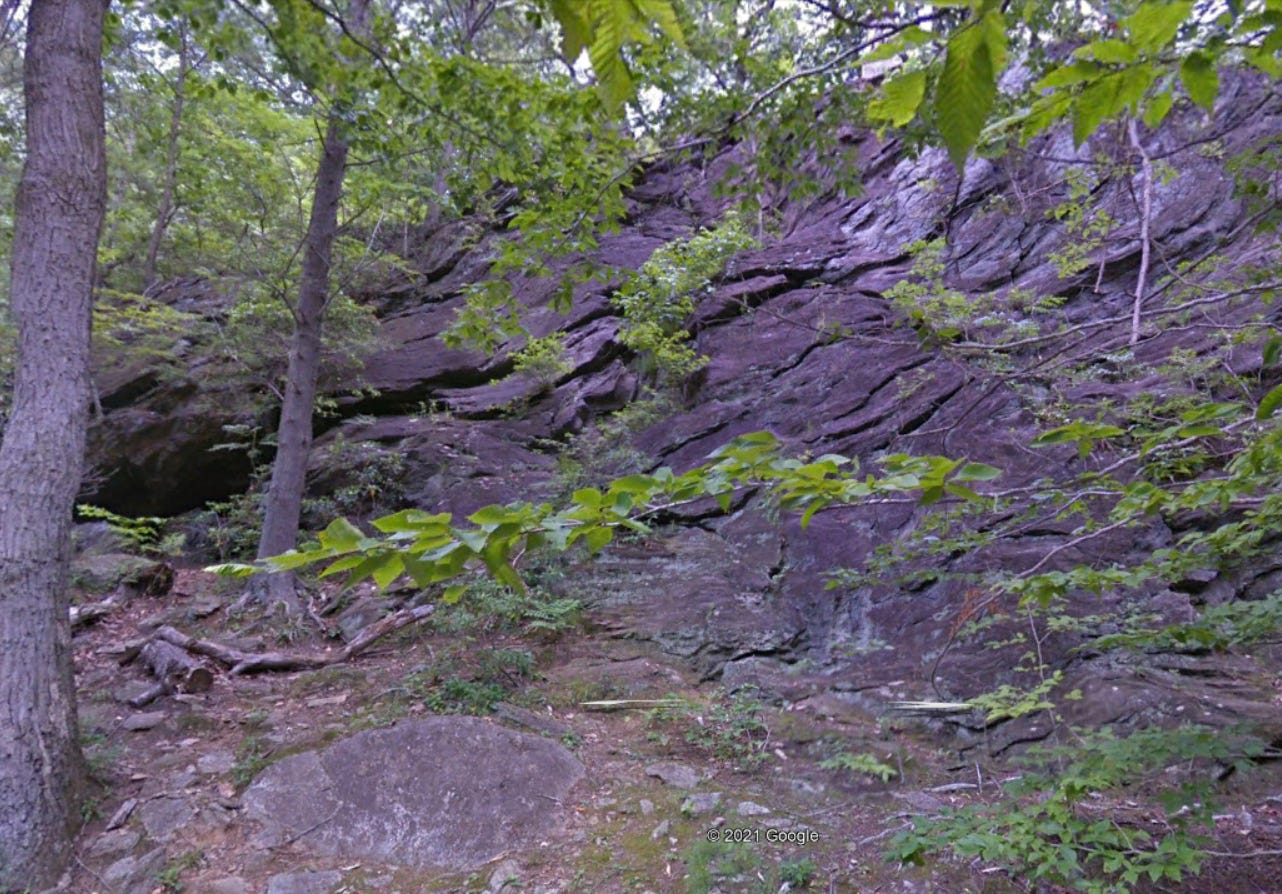On one of the secluded bluffs overlooking the Wissahickon Creek, there stands a statue of a man in Quaker garb. He’s often assumed to be William Penn, but this is mistaken- he’s no one in particular, and could represent any of the Quaker men who founded Philadelphia. The only identifier given to the statue is the word “TOLERATION” chiseled into its base. Mr. Toleration is unusual among the statues dotting Philadelphia for his incredibly out-of-the-way location, atop a lonely outcropping known as Mom Rinker’s Rock. Most hikers stumble upon him by accident while exploring the obscure upper reaches of the creek.
I visited the place with my Dad for a school project once and it’s not easy to get to. The Wissahickon gorge is a wilderness of steep slopes and twisting canyons. In autumn, a thick carpet of fallen leaves conceals dangerous rocks and crevices- it’s very easy to sprain an ankle here if you’re not careful. To get to the Rock from the street we came in on, you have to cross over a little brook via a high-level sewer pipeline, which is smooth and round and easy to fall from if you’re not careful. Once we crossed, my Dad and I struggled to ascend the steep, scrambling slope up to the statue, which is barely visible from the bottom of the Rock. When we got up to the top, we found an elderly Asian couple resting on a boulder, looking at the statue. I needed pictures for my project, but to my chagrin there were no good angles of it from the front, because it stands at the very edge of a forty-foot drop. All of this description is to give you an idea of how wild and untamed the area is even today, despite it being well within Philadelphia and only about five miles from Center City.
Mom Rinker’s Rock itself makes an imposing sight. It’s a solid mass of black gneiss jutting up from the valley like the prow of an ironclad. A narrow passage separates it from a lower, rounder outcropping standing immediately beside it. The texture of the Rock suggests a volcanic past- rippling layers of dark stone, as though a wave of magma had lurched out of the ground and solidified in the same instant, permanently preserving its gnarly, undulating pattern. The entire gorge is metamorphic rock of Precambrian vintage, so this may not be too far from the truth. And once you ascend past this monument of deep time to the top, you find that the crest of Mom Rinker’s Rock is a level plateau, again giving a maritime impression of the deck of a ship.
But who is Mom Rinker? And why does she have a rock named after her? These are both excellent questions and there are two entirely different stories to answer them.
The first story is more fun, in my opinion. According to legend, Mom Rinker- sometimes confusingly referred to as Mom Rinkle or Molly Runker, though it’s certain they are all the same character- was a witch, who lived up on the rock that now bears her name. I’m extremely fond of this passage from The Story of Philadelphia by Lillian Ione Rhoades, published in 1900:
There is a legend that Mom Rinker was a witch; that she rode to the moon on a broomstick; that she drank dew from acorns; that she had an evil eye that soured the neighbors milk, and that she fell from this cliff and was killed. It is no doubt true that she brewed strange decoctions from the herbs, roots, and bark of trees, but the rest of the story is fanciful.
And that tantalizing little paragraph contains essentially all of the information one will find about Mom Rinker the witch. A few other scraps of information have been handed down to us- that as a perk of her compact with the Devil, she couldn’t drown and simply floated down the creek to the sea, and that rifle bullets couldn’t penetrate her skin.
One man going by the name Mr. Meehan was quoted in a 1901 edition of The Philadelphia Record with a little more information about the witch’s demise:
From this rock towering over the dark waters of the Wissahickon, she nightly mounted her broomstick and set off on her weird flights. But, one night, whether owing to excessive indulgences in the witch’s revels or to some other cause, instead of soaring from the rocks, she fell — the sharp crags dashed the life out of her — and the waters of the creek toyed with her lifeless body.
She must’ve felt a little silly for not asking Old Scratch to make her immune to fall damage in addition to making her bulletproof!
The second story about Mom Rinker is probably a little more historical. In this tale, Mom Rinker wasn’t a witch at all. She was an American patriot in the War of Independence. During the Philadelphia Campaign, after being ousted from the city, the Continental Army hung around, establishing their first winter camp at White Marsh in 1777, trying to figure out how to retake Philadelphia before eventually retreating to Valley Forge for the remainder of the winter. General Washington recognized the value of espionage in military operations, and cultivated an extensive network of spies in the city to eavesdrop on the British. Mom Rinker was one such spy, and she had a unique method of getting information to the Continentals.
According to this legend, Rinker was an inkeeper in Germantown. After the British marched into town, they billeted some of their officers at her family’s ancient inn, the Buck Tavern, and Mom Rinker was forced to serve them dinner and ale. Don’t get excited- she was a rather old lady at this point, not a sexy tavern wench by any means. Her constant presence in the room allowed her to overhear many conversations between Redcoat officers, and as the evenings dragged on and jugs of ale were drained, lips were loosened and the Redcoats whispered things that should not have been spoken. Mom Rinker overheard a lot from those drunken soldiers, and late in the evening after they had staggered off to their rooms, she would take little slips of paper and write down any information she found pertinent to the Patriot cause. Come morning, she would head out to the Rock with a basket of yarn and a pair of needles.
Here, atop her Rock, Mom Rinker would sit peacefully and knit socks and scarves. It was also said that she had the best-bleached flax in the neighborhood, because she would lay it out all day on one of the warm boulders atop the cliff, where the sun’s rays seemed to linger longer than anywhere else in the valley. While her flax was warmed by the sun, she would perch herself at the edge of the Rock and knit. Probably humming a song to herself as she threaded her needles- could this be where the legend of the witch Rinker muttering to herself originated?
But her knitting was only a ploy. Hidden away within some of her balls of yarn were the missives she jotted down back at the inn. She wrapped the scraps of paper around a little stone, then twirled yarn around this core until she had a normal, nondescript ball in her basket. Surreptitiously, she would let these faux balls of yarn roll over the edge of the Rock, where they would be retrieved by a Continental dispatch rider waiting in the crags below.
What a brilliant and unique plan! Who would ever suspect little granny Rinker, a frail, perfectly innocuous old lady just knitting socks on her favorite rock? Apparently a few of the local Tories were suspicious, as she was followed at least once, but all they ever discovered was an innocent old lady knitting peacefully on a sunkissed stone. And no dispatch riders or hidden couriers were ever caught either. The jagged geography of the Rock provides so many hiding places one can imagine one of the Green Boys- the fierce Patriot guerrilla fighters of Roxborough who also picked up Mom Rinker’s messages- hiding in the crevice below, flattening his body against the wall and holding his pistol tightly to his chest, while forty feet above Mom Rinker was interrogated by a Tory quisling.

Whether there’s more truth or legend to these two tales is up in the air, but I personally love these stories. Mom Rinker was one of the first local heroes (or villains, depending on whether you prefer the Patriot or witch interpretation) I ever read about, and I love how enigmatic she is. There’s tantalizingly little information available, even spread across many different sources. And to me that makes the story more wonderful, because you can let your mind fill in a lot of the blanks.
I’m still baffled by how these stories revolve around the same woman despite not being connected in any way. Mom Rinker may have been a witch or a Patriot- or maybe she was both! Maybe after the war she retired from spycraft and got into the habit of drinking dew from the cups of acorns and flew to the Moon on a broomstick. What isn’t up for debate is that some time in the late 1700s, an old lady sat atop a jagged, plutonic slab overlooking the Wissahickon, and the city still remembers her for it.
Sources
The Story of Philadelphia by Lillian Ione Rhoades, 1900
Turncoats, Traitors, and Heroes by John Bakeless, 1959
The Wissahickon in History, Song, and Story by Joseph D. Bicknell, 1908
George Washington, Spymaster by Thomas B. Allen, 2007
Philadelphia: The Birthplace of the Nation, the Pivot of Industry, the City of Homes by Henry Graham Ashmead, 1904
Fairmount Park: Sketches of Its Scenery, Waters, and History by Charles Shearer Keyser, 1872
The Wissahickon compiled by T.A. Daly, 1922
Mom Rinker’s Rock by History At The Table
Mom Rinker- The Little Ol’ Lady Who Spied for Washington by Heather Frey Blanton
The Spy Who Knitted Socks by Roving Crafter
Toleration Statue Has Rich History by Barbara McCabe
The William Penn look-alike and the spy/witch of the Wissahickon Valley by Philly History Photos







